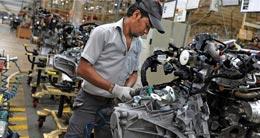“Make in India” gets a Canadian boost

Narendra Modi’s mission of 'Make in India' is a little bit closer to reality with a new partnership between Colleges and Institutes Canada and the National Skill Development Corporation of India.
The partnership, signed during the Indian prime minster’s recent visit to Canada will undertake part of the mammoth task of upskilling India’s youth population.
Modi’s mission of 'Make in India' can not become a reality unless we have adequate skilled manpower in the country, Union Minister Rajiv Pratap Rudy said.
"Students need to be taught entrepreneurial skills to gain confidence and become job creators," the Minister of State (Independent Charge) for Skill Development and Entrepreneurship Rudy said at the recent India Today Conclave.
"As the market for quality plumbers, electricians and carpenters continues to expand, there is a growing need for vocational and skill training," he added.
Rudy also said that there should be more emphasis on holistic education rather than on only promoting sciences.
The Indian government is currently in the process of revising the National Skill Development Policy, which had been devised by the ousted Congress-led UPA government in 2009.
The skilled workforce in South Korea is 96 per cent, 80 per cent in Japan, 75 per cent in Germany and 70 per cent in Britain. Compared to this, the skilled workforce in India is only two per cent.
A recent analysis by the South Asian Post showed almost a quarter of India's young are jobless, according to figures released by the Indian government, based on tabulated data from 2011.
Despite a healthy economic growth of about 8 per cent per annum in the past decade, about 47 million young Indians, or 20 per cent of the country's 15 to 24 year olds, were without jobs in 2011.
Although the majority are educated, unemployed young males, almost 20 million are young women.
Many women are educated, but choose not to work because of family pressure to stay home.
Prime Minister Narendra Modi has promised to build 100 new cities, a high-speed train network, and skill development for the young. His hope is to show that with scale, speed and skills, India can compete with China.
The skill shortage means India could squander the potential demographic dividend of 12 million people joining the labour market a year, just when China's workforce is expected to lose 6 million over the next decade because of its ageing population.
"India, so far, has been a country that celebrated knowledge and intellect. Skills are not celebrated," said Rituparna Chakraborty, president of Indian Staffing Federation, which represents the country's employment agencies.
China became a manufacturing giant by steering secondary school students into formal skilled training programs.
By contrast, in India, students who do not go on to tertiary education have few vocational options other than government-run Industrial Training Institutes (ITIs) that executives say are poorly managed and often outdated.
For example, the ITI syllabus for car mechanics includes considerable training on carburettors, which were widely phased out of cars in the 1990s.
The scant training available means that India only has 3.5 million workers undergoing skills courses a year, compared with 90 million in China, according to Indian government data.
The lack of proper training is compounded by prejudice against manual labour under the Hindu caste system, which has traditionally left jobs that might get your hands dirty to the lowest of the low.
As a result, only one in 10 workers in India's construction industry are skilled, according to government data.
The government has a goal to provide at least some skills to 500 million people by 2022. But private companies such as the Godrej Group are taking matters into their own hands, recruiting and training workers themselves to be ready with skilled labour when an economic recovery comes.
"I always say that there is no unemployment in India. It's only unemployability," said Adi Godrej, whose businesses range from consumer goods to real estate and infrastructure.
The Canada-India agreement will facilitate multiple sector collaborations for capacity development and the establishment of National Occupation Standards (NOSs). As India embarks on an ambitious education reform, this new framework for collaboration will pave the way for initiatives in a variety of sectors such as curriculum development, teaching and learning resources development, occupational standards, testing and certification and labour market information system.
“We are honoured to be signing this new MOU with India’s NSDC”, said Canadian Colleges and Institutes (CICan) President and CEO, Denise Amyot.
“Canadian colleges and institutes have a wealth of knowledge and expertise to share and we look forward to strengthening ties with our Indian partners to support them in their education reform.”
Canada already has strong ties with the Indian post-secondary sector and over 8000 Indian students were enrolled last year in colleges and institutes across Canada.
“This partnership with Canada is important for us in multiple ways”, says NSDC managing director and CEO, Dilip Chenoy. “Canada has experience in many sectors that India is looking at, such as green skills, agriculture or water management that fit with specific needs of the Indian economy. This is also a great way to bring a new dimension to the Canada-India trade relation. As Canadian firms invest in India, what better to have people who are being trained and certified with Canadian standards.”
Colleges and Institutes Canada is the national and international voice of Canada’s publicly supported colleges, institutes and polytechnics. We work with industry and social sectors to train 1.5 million learners of all ages and backgrounds at campuses serving over 3,000 urban, rural and remote communities in Canada. The Association operates in 29 countries via 12 offices around the world.









